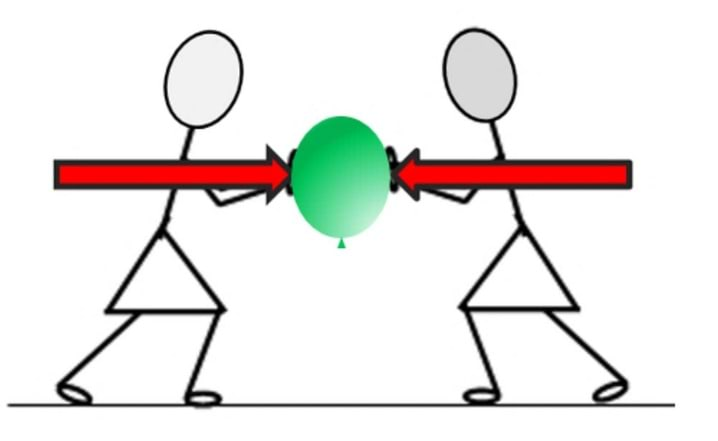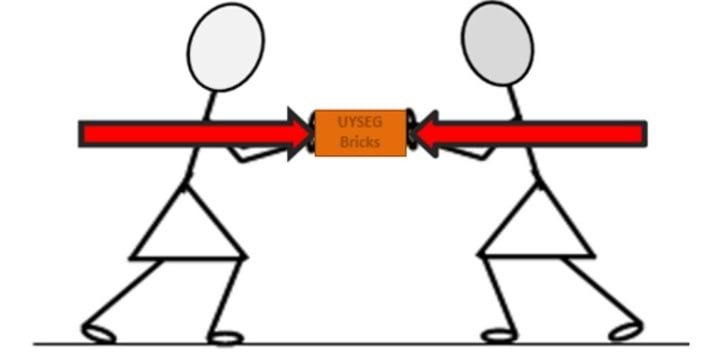Learning focus: | The resultant force is the sum of the forces acting on the object, taking into account their direction. If there is no resultant force, the forces are balanced. Unbalanced forces change the speed, direction and/or shape of an object. |
Observable learning outcome: | Describe what happens when two equal sized forces act on an object, both acting along the same straight line but in opposite directions. |
Question type: | Diagnostic, simple multiple choice |
Key words: | Balanced forces |
Driver et al (1994) identify several common misunderstandings that are addressed by this question:
- if there is motion, there is a force acting
- if there is no motion, then there is no force acting
- there cannot be a force without motion
The first of these is very widely held because in everyday experience, when cycling or driving for example, we do need to apply a constant force in order to move at a steady speed in order to match friction and air resistance. This means that when an object is not moving it is wrongly perceived to have no force acting on it and the other misunderstandings can follow. Indeed, Driver et al (1994) point to a study of 1000 Norwegian upper secondary students, by Sjoberg and Lie (1981), which found just 50% of the young people recognised ‘passive’ forces acting when there was no movement.
This diagnostic question challenges the misunderstanding that there is no force on a stationary object by first considering how balanced forces clearly distort the shape of an elastic balloon, and then extending the same thinking to a very much more rigid brick. Thinking about the ‘invisible’ changes to the shape of the brick introduces students to an idea they will need in order to understand the reaction force later in their studies.
Students should complete the question individually. This could be a pencil and paper exercise, or you could use an electronic ‘voting system’ or mini white boards and the PowerPoint presentation. The answers to the question will show you whether students understood the concept sufficiently well to apply it correctly.
If there is a range of answers, you may choose to respond through structured class discussion. Ask one student to explain why they gave the answer they did; ask another student to explain why they agree with them; ask another to explain why they disagree, and so on. This sort of discussion gives students the opportunity to explore their thinking and for you to really understand their learning needs.
Differentiation
You may choose to read the questions to the class, so that everyone can focus on the science. In some situations it may be more appropriate for a teaching assistant to read for one or two students.
Most students will recognise that the balloon changes shape and is squashed when balanced forces are applied. With careful questioning you should be able to explore your students’ thinking about what is happening to the balloon to identify:
- The force of each girl’s hand on the balloon
- The force of the balloon on each girl’s hand …
- … which is obvious because the balloon is very elastic and ‘springs’ back when it is released.
The brick does not obviously change shape and a significant number of students are likely to choose answer A. A good response to this might be to use the balloon example as a model and discuss how the brick and the balloon compare. In both examples:
- The harder the girls push, the harder they feel the brick / balloon push back
- They are both actively pushing on the brick / balloon during the time it is not moving …
- … so there are forces pushing, which can be explained if the brick is behaving like a (very stiff) spring that has been squashed.
The BEST physics topic PFM3: More about forces develops students’ understanding of reaction forces. At this stage the important concept for students is that forces continue to act in situations where they are balanced.
Health and safety
If you choose to demonstrate this, it is advisable to use a piece of wood instead of a brick (hard, but lighter in weight), and to push over a bench with something like a piece of old carpet protecting the surface. The danger here is that a heavy object falling to the floor can cause injury. There is also a risk of students pushing too hard or getting carried away, and careful selection may be necessary.
Practical work should be carried out in accordance with local health and safety requirements, guidance from manufacturers and suppliers, and guidance available from CLEAPSS.
Driver, R., Squires, A., Rushworth, P. and Wood-Robinson, V. (1994) Making sense of secondary science, research into children’s ideas, Routledge, London, England.
Sjoberg, S. and Lie, S. (1981) Ideas about force and movement among Norwegian pupils and students, Institute of Physics Report Series: Report 81-11, University of Oslo.

